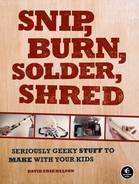Thoroughly wash the can, then use a can opener to remove the top, leaving the rolled aluminum ring intact (Figure 19-3). Depending on your can opener, the top may come off more easily if you turn the can opener’s crank backward.
Measure 2 1/2″ down from the can’s shoulder (Figure 19-4), marking this length at several points around the can’s circumference.
Use a utility knife to carefully cut away the bottom of the can, with the goal of keeping the flyer’s body length uniform without slicing open your finger.
Take your Pop Can Flyer for a test drive. Throw it like a football, with the can’s top in front and plenty of spin.
If you have lots of cans handy, experiment with different body lengths (2 1/2″ from shoulder to cut gives good results; you can try going as short as 1 1/2″ or as long as the full can). Shorter cans have greater in-flight stability but less stable overall paths (they tend to juke or weave unpredictably). Cans with different diameters (such as a big Foster’s can or the pint-and-a-half tallboys from Labatt) will have different optimal lengths.
Warning
The trailing edge of the Pop Can Flyer might be sharp; this isn’t baby’s first football, and don’t throw it at the cat.
Also try different trailing edges—dips and lobes, a jagged zig-zag, or even asymmetrical cuts—or adding one or more cutouts to the sides (Figure 19-5). To add a cutout, slip the flexible can over the end of a broom handle or mailing tube to support it as you cut (as shown in Figure 19-6). Work slowly—you don’t want to crease the can or open a vein. Cutouts tend to decrease the flight distance, but keep it on a straighter path.





